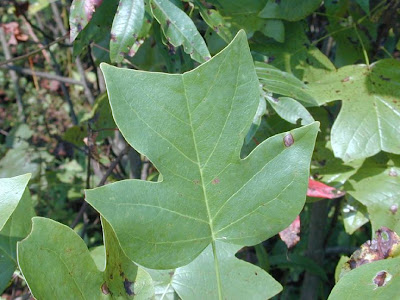Turns out it's not an aphid, but a scale, in particular the Tuliptree Scale, Toumeyella liriodendri. The light brown circles are the Tulip leaf scars. The scale is the orange bump in between. Scales are homopteran insects related to Aphids, and currently classified in the order Hemiptera. Scale insects are round to flat, but start their life crawling around plants. When they find a suitable spot, they pierce their beak into the bark and begin to suck on the sap. They remain immobile at this point, increasing in size, and forming a hard shell on their back.
A small amount of scale don't cause much of a problem, but large infestations will make the twigs appear to be covered in bumps or warts. Small or weakened trees can suffer mortality from repeated feedings year after year. Malathian and Sevin are insecticides used to control these pests. If you prefer, you can just spray water mixed with soap or cooking oil, so as not to kill beneficial insects in the area. The best time to spray is in September or early spring as buds and leaves begin to expand.
Tuliptree Scale is one of the larger scales in North America. This early in the season they are about 1/8 to 1/4 inch in size. By the end of the summer, the females may be over a half inch in length. Rounded scales like this can always be recognized by the turtle shell shape.
The males are much smaller. Judging by the size of the holes in the gray-white ones visible here, it is likely they have been attacked by a parasitic wasp. In the fall there are winged adults that mate and lay eggs for next year. The young crawlers hatch out in the same year and spend the winter in their first instar or stage of life. Spring came early, and it has been both warm and dry. This may contribute to the high numbers we are seeing this year. There are reports from West Virginia to Indiana about the large populations being noticed this season.
During large infestations, so much sugar water, or what is called 'honeydew', forms a solid film on the twigs and leaf surface. It's very sticky to the touch.
Insects are not the only thing that feeds on honeydew. A fungus called the Black Sooty Mold will turn both leaves and branches black. The mold will start out flat, and grow upright to form a cushion shaped structure.
This is Black Sooty Mold as it grows larger. I showed pics of this on my Aphid post back in January. This mold when wet can be heavy and snap twigs off on small plants. Generally it's not a big problem, more cosmetic than anything. The scale insects themselves are the real concern.
As a sidelight, I noticed a few leaves in this condition. Having not seen what caused this, I once again can't be sure. But between 1989 and 1992 there was a serious outbreak of the Tuliptree Weevil, a beetle that makes Swiss Cheese out of leaves. It's been twenty years, but I guess we better keep an eye out for this possible pest as well.











I've been seeing these scales on the tuliptree in my yard over the past week and was wondering what it was. Thanks for clearing that up for me Dennis! Also, you can probably be confident about the tuliptree weevil--I've found them on my tree every summer for the past few years (including this one) and have seen their effects on the leaves.
ReplyDeleteDennis, speaking of insects that are out early, i've seen several masses of fall web worms already!
ReplyDeleteRobyn, don't let the name fool you. Fall Webworms are common throughout the summer. I see them often in June, but you are right, it is early for them.
ReplyDeleteDennis, Nice blog and awesome photography! We're seeing this critter all over SE Ohio. By far the worst I've ever seen. I'm guessing this is another way that we are paying for the very mild winter?
ReplyDeleteHope all is well!
Dave Apsley
http://seohiowoods.wordpress.com
DAVE!!! Thanks for stopping by.
DeleteNice poost
ReplyDelete